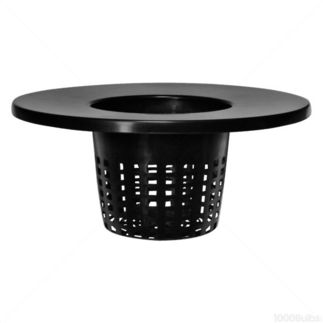Lately my interest has peaked in aquaponics and hydroponics. As a hydrogeologist, I like toying with the concepts of dissolved nutrients in water, and how the parameters of water can influence the biosphere.
Hydroponics
Hydroponics is a method of growing plants without soil, using nutrient-enhanced water. Commonly, the plants will root in a growing medium, such as sterile pellets, or be embedded in floating mat. Hydroponics is a form of geek gardening that allows for precise control of most of the variables controlling the viability of the plants. You can decide the exact nutrients that the plants get and decide how frequently the root system is exposed to water. Some gardeners prefer continuous root exposure to water, while others alternate between cycles of saturated and unsaturated or use a drip line to provide water.
| A simple drip hydroponic setup using a rain gutter. The gutter is usually filled with a growing medium like expanded clay pebbles or rock wool. Nutrient-rich water is pumped and dripped to each plant. The gutter is oriented in a way that allows for gravity drainage of the water back to the bucket. From: Gregory Axt. |
Some of the lease expensive hydroponics setups use PVC or rain gutters to hold their plants and network water. The PVC system pictured is likely a Nutrient Film System, where a shallow, slow-flowing stream of nutrient-enhanced water is circulated through the pipes. From homestead-hydroponics.
|
Generally, an air stone is introduced into the reservoir to add oxygen into the water and to prolong dissolution of the nutrients. While plant use carbon dioxide for photosynthesis, their roots require oxygen.
Aquaponics
Aquaponics is a type of hydroponics that uses fish to provide the nutrients required by the plants. Oftentimes, a special type of fish food is used to help promote an ideal nutrient balance for the plants. Commercial-scale aquaponics systems actually grow both edible plants and edible fish. However, most smaller-scale home aquaponics systems use less palatable fish such as goldfish. I like aquaponics because it promotes the concept of symbiosis, where plants rely on the fish waste for nitrates and the fish need the plants to eliminate/reformulate those nitrates. Because fish are providing the nutrients for the plants, you want to use high quality fish food designed for aquaponics.
| Basic aquaponics setup from DIY aquaponics website. This is a variation on the ebb and flow system and includes a self-draining bell siphon. Here are some excellent instructions on how to build a self-draining bell siphon for an aquaponics ebb and flow system. |
| This is an excellent graphic of the aquaponics nitrogen cycle from the Backyard Aquaponics website. |
| The size of aquaponics systems can vary dramatically. Backyard Aquaponics offers free plans on how to build these cool barrel systems. |
The addition of an aquarium water heater to an aquaponics system could help enhance yield and growth rate, as well as growing season.
Aquaponics relies on bacteria to convert the nitrate into a usable form. Creating an area for those bacteria to grow makes these systems more effective. This guy used a filter that promotes multiplication of these bacteria.
For more information about aquaponics, check out this awesome guide by Backyard Aquaponics.
Colorado Aquaponics also wrote a nice presentation on the subject.
Aeroponics
A variation on hydroponics is aeroponics, where roots are exposed to air. This technique can enhance root growth.
 |
| A cross section of the Tower Garden aeroponics system. |
| An aeroponics setup from user GpsFrontier on the hydroponics-online forum. |
Links
Window Farms hydroponicsHydroponics setups for cheap on Instructables.
Another aquaponics manual
Aquaponics nutrients
More on aquaponics nutrients










